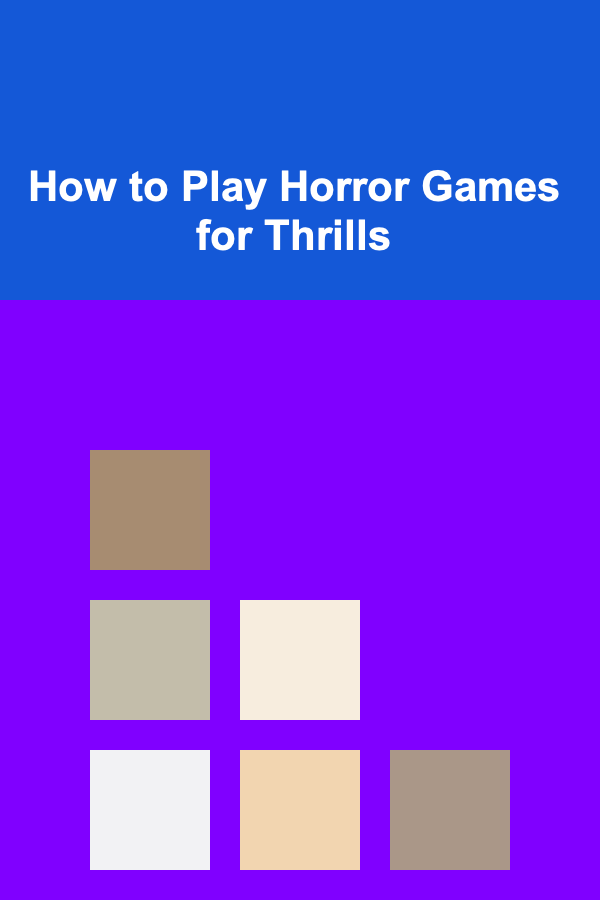
How to Play Horror Games for Thrills
ebook include PDF & Audio bundle (Micro Guide)
$12.99$11.99
Limited Time Offer! Order within the next:

Horror games are a genre that attracts a specific kind of thrill-seeker. They are designed to immerse players in unsettling atmospheres, evoke fear, and test psychological endurance. The thrill of horror games comes from their ability to invoke suspense, surprise, and dread, which leads to an emotional rollercoaster. For many players, this terrifying experience is what makes these games so enjoyable. In this article, we'll explore how to play horror games for thrills, including the psychological elements that make these games so compelling, techniques for enhancing the experience, and the importance of pacing and game design.
The Psychology of Fear in Horror Games
Understanding why horror games are thrilling starts with examining the psychology behind fear. Fear is an instinctive response designed to keep us safe from danger. When we play a horror game, the brain reacts to simulated threats in much the same way it does to real ones. This is what makes horror games so gripping --- they trigger our fight-or-flight response, even though we are fully aware that we are just playing a game.
There are several psychological elements that contribute to the effectiveness of horror games:
1. Anticipation and Anxiety
One of the most powerful tools used by horror game developers is anticipation. Often, the scariest moments in a game come not from what is directly in front of you but from what you anticipate might be lurking around the corner. The fear of the unknown, combined with the inability to see what's coming next, builds tension. This fear is heightened by atmospheric sounds, such as eerie music or the sound of footsteps that increase in volume as a creature draws closer.
Games like Amnesia: The Dark Descent and Silent Hill 2 masterfully play on this sense of dread, keeping the player constantly on edge by withholding immediate threats and letting their imaginations run wild.
2. The Uncanny Valley Effect
The uncanny valley refers to the eerie feeling we get when something looks almost human, but not quite right. Horror games often use this concept to make players feel uncomfortable. Characters with slightly off facial expressions or distorted bodies invoke a primal unease, triggering the brain's sense of something being "wrong."
This is evident in games like Resident Evil or Dead Space, where the characters or enemies look grotesque, yet familiar, unsettling our perception of reality. The horror becomes more real and immediate because the uncanny design taps into deep-seated fears of the unknown.
3. Vulnerability and Powerlessness
Horror games often emphasize vulnerability. Unlike many other genres where players control powerful heroes, horror games often give players minimal means of defense or control. Whether it's running away from a monstrous creature or having limited resources, players feel helpless, amplifying the fear factor.
In games such as Outlast, players are trapped in an environment where they must hide or escape from terrifying threats without the ability to fight back. This sense of powerlessness is terrifying because it forces players to rely on their wits and instincts rather than sheer combat skill.
4. Isolation and Loneliness
Another common tactic in horror games is the feeling of isolation. Often, the protagonist is alone in a dark, abandoned, or nightmarish world. The absence of other characters, coupled with eerie environments and sounds, creates a feeling of loneliness and alienation.
In games like The Evil Within or Soma, the player is often separated from any potential help, creating a sense of abandonment and helplessness. These feelings feed directly into the fear response, as we are not only threatened by the environment but also by the realization that no one else can help us.
Techniques for Playing Horror Games for Maximum Thrills
While horror games are designed to induce fear, your experience can be greatly influenced by how you play them. Here are several techniques to maximize the thrill factor:
1. Immerse Yourself in the Atmosphere
The best way to get the full horror game experience is to fully immerse yourself in the game world. The more you can suspend disbelief and let yourself get lost in the atmosphere, the more intense the game will feel.
Here are some ways to enhance immersion:
- Play in the dark: Horror games rely heavily on visual and auditory elements to create tension. Playing in a dark room with minimal light heightens the sense of isolation and suspense.
- Use headphones: Horror games are known for their incredible sound design. Using headphones will help you pick up subtle sounds --- creaks, footsteps, distant whispers --- that you might miss on speakers. The right audio cues can build tension and signal impending danger.
- Get comfortable: Physical comfort can help you focus on the game's narrative and gameplay rather than distractions in your environment. Whether it's sitting in a comfortable chair or using a gaming chair, being relaxed allows you to better absorb the psychological effects of the game.
2. Focus on the Story
One of the reasons horror games are so thrilling is because they often come with deep, emotionally engaging narratives. These stories may involve uncovering mysteries, facing horrific entities, or surviving through intense situations.
If you want to get the most out of your experience, focus on the story and its characters. Games like Silent Hill or Layers of Fear have complex narratives that unfold slowly, adding layers of mystery and dread. By paying attention to these details, you'll develop a deeper connection to the plot and characters, which will make the scares hit harder when they occur.
3. Pacing Is Key
Horror games excel at creating tension through pacing. Developers know when to let you breathe and when to ratchet up the tension. Fast-paced action and jump scares can startle players, but it's the moments of quiet, slow dread that are often the most effective.
When playing a horror game, try to embrace the quieter, slower moments. These segments build tension and provide space for the story to develop, making the eventual scares much more impactful.
4. Take Breaks
While horror games can be exhilarating, they can also be mentally and emotionally exhausting. Playing for long periods can desensitize you to the scares or, conversely, overwhelm you, making it harder to enjoy the experience.
If you find yourself feeling fatigued, take a break. Step away from the game for a few minutes to calm your nerves. These pauses can help you reset, making the next terrifying moment even more intense when you return.
5. Challenge Yourself
Many horror games come with difficulty levels that can change how scary the game feels. Playing on a harder difficulty can make the game more challenging by limiting your resources, increasing enemy difficulty, or restricting certain gameplay mechanics.
If you want to amplify the thrill, consider playing on a higher difficulty. The increased tension and danger can make the game feel much more intense and rewarding. However, make sure to assess your tolerance for fear --- playing a game on the hardest difficulty might become too overwhelming if the scares are too much to handle.
The Role of Game Design in Creating Thrills
The success of a horror game depends not just on its story and atmosphere but also on the design choices made by developers. These design elements shape how the player interacts with the game world and how they experience fear. Here are some key components of game design that contribute to the thrills of horror games:
1. Lighting and Shadows
Lighting plays a significant role in horror games. Dim, flickering lights and long, eerie shadows are commonly used to disorient the player and create a sense of unease. Games like Alan Wake use light and dark to control the player's experience, where some areas are safe when lit, while others are dangerous when shrouded in darkness.
By manipulating lighting, game designers can control how much the player can see and what they can't, creating an atmosphere of mystery and anticipation.
2. Sound Design
Sound is a crucial element in horror games. From subtle background noises to loud, jarring audio cues, sound builds the atmosphere and signals when danger is near. A good horror game will use sound not only to signal the presence of threats but also to build suspense.
The use of silence is equally important. In games like The Last of Us or Outlast, silence often indicates a lull before a storm. The absence of sound makes the player hyper-aware of their surroundings, increasing the fear of what might happen next.
3. Enemies and Monsters
The design of the monsters or enemies in a horror game is crucial for evoking fear. The more grotesque, unnatural, or unpredictable these creatures are, the more terrifying they become. However, it's not just the design but also the behavior of these enemies that makes them effective.
Games like Resident Evil or Amnesia feature monsters that seem to appear out of nowhere, following players in relentless pursuit. The unpredictability and relentlessness of these enemies create an intense level of fear.
4. Environmental Storytelling
Many horror games excel in telling stories through the environment. Instead of relying solely on dialogue or cutscenes, the game world itself offers clues about what has happened and what's to come. This is known as environmental storytelling.
In games like The Evil Within or Bloodborne, the environment itself is drenched in foreboding imagery. A dilapidated building or an abandoned town can evoke a sense of lost history, adding an eerie atmosphere. These visual cues feed into the player's sense of dread, reinforcing the fear that something is lurking just beyond their sight.
Conclusion
Horror games offer a thrilling experience that taps into some of our most primal fears. Whether it's the fear of the unknown, the sense of isolation, or the thrill of surviving against overwhelming odds, horror games are designed to deliver an emotional rollercoaster that few other genres can match. By understanding the psychological elements that contribute to the fear, immersing yourself fully in the atmosphere, and taking advantage of game design features, you can amplify the thrill and have a truly spine-tingling gaming experience.
The key to enjoying horror games for the thrills lies in embracing the tension, exploring the narrative, and challenging yourself. So, the next time you dive into a horror game, remember to turn off the lights, plug in your headphones, and prepare for a journey into the unknown.

How to Customize Your Meeting Preparation Checklist for Different Meeting Types
Read More
How to Set Up a Checklist for Implementing Two-Factor Authentication (2FA)
Read More
How to Set Up a Financial Cushion for Your Retirement Years
Read More
How to Stage Your Home for a Family-Friendly Vibe
Read More
How to Improve Your Relationship with Food for Weight Loss
Read More
How to Minimize Taxes on Your Investments
Read MoreOther Products

How to Customize Your Meeting Preparation Checklist for Different Meeting Types
Read More
How to Set Up a Checklist for Implementing Two-Factor Authentication (2FA)
Read More
How to Set Up a Financial Cushion for Your Retirement Years
Read More
How to Stage Your Home for a Family-Friendly Vibe
Read More
How to Improve Your Relationship with Food for Weight Loss
Read More